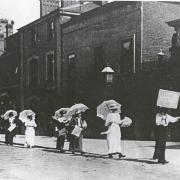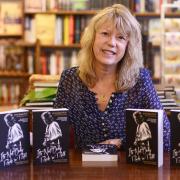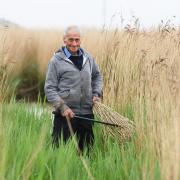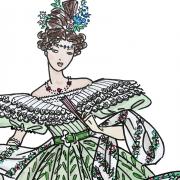The author of The Other Boleyn Girl, Philippa Gregory, has written a history of the women of England featuring fascinating stories from Norfolk.
We don’t know most of their names and stories – but they made history.
Now Philippa Gregory has hunted down the women who were an equal part of our past, but erased from the telling of our story.
She wants to restore the place of ‘invisible’ women, hidden in the shadows created by history which focuses on men and is researched and recorded by men.
Vanishingly few women are even remembered by name but occasionally a woman breaks through.
Emma was just 16 when she held Norwich Castle against the forces of the king.
She had already defied William the Conqueror to marry the Earl of East Anglia. Her husband and brother rose up against Norman rule but when the rebellion failed the earl fled for his life. Emma held the king’s castle, in Norwich, for three months, until he agreed to her safe passage to rejoin her husband.

Perhaps there was something about the women of Norfolk and kings and castles as two centuries later Alice Knyvet held Buckenham Castle against attackers sent by the king.
However, women at the head of fighting forces was not normal, even for Norman Norfolk.
And despite highlighting this high-level historic girl power author and historian Philippa’s latest project aims to put ordinary women centre-stage.
Instead of focusing on kings and queens, Normal Women, 900 years of making history reinstates some of the women who have been crowded out of history.
Best-known as a historical novelist, and author of The Other Boleyn Girl, which was made into two films, Philippa is also an authority on women’s history and a Tudor expert for Channel 4's Time Team.
Her fiction blends fact and imagination, breathing life into real women from history. This non-fiction project retells the real stories of English women from 1066 to 1994, when women were first ordained as priests by the Church of England.

Combining scholarship and storytelling, Philippa features women who farmed, traded, built ships and houses, campaigned, rioted, fought in jousts and were inventors, soldiers and miners.
She begins in 1066 when she finds women working as brewers, blacksmiths, builders, doctors and road repairers. Women joined the Crusades to the Holy Land, and there were even women-only marriages.
Although women were defined by their relationships to men for much of the 900 years, many ran small businesses, some bought property and in Norwich by 1418 women were able to join the prestigious Guild of St George on an equal footing with men.
‘The many thousands of normal women I researched for this book had left a just a tiny trace – a footnote, a court report, or a line in a will. For the last 10 years, I’ve been following these threads to reassemble the history of women in England,’ said Philippa. ‘I am indebted to the work that historians of women have already done, from the early 1900s when women were able to study history at university, we see the first great histories of women appear, they are succeeded by biographers of heroines, family histories, social historians and then editors of lists of top ten women. All these publications describe women in different contexts and I drew on them to write a national history of women across nine centuries.’
In Norwich she finds Cecily Baldrye, licensed as a surgeon by the Bishop of Norwich in 1568, despite women being officially forbidden to practise medicine or surgery at the time.
Then there is 85-year-old Norwich widow Janis House who was refused a welfare payment in 1570 because she was still able to earn money by spinning wool.
By 1660 it was actually illegal for single women not to work and women living alone in Norwich risked being sent to a ‘house of correction,’ whipped or forced into domestic service.
Philippa also finds Norwich fathers ‘selling’ their daughters to agreed bridegrooms in the 1660s, in what she calls a traditional ‘wife sale.’
Some stories are particularly horrific. A servant was boiled in oil in King’s Lynn marketplace in the reign of Henry VIII for poisoning her mistress.
During the reign of his daughter, Mary, more than 300 people were executed for refusing to renounce Protestant religious beliefs.

Cicely Ormes, born in Dereham and living in the parish of St Lawrence in Norwich, was burned at the stake in the city in 1557.
She had initially renounced her Protestant beliefs but decided she could not accept Catholicism. Given the chance to save herself because she was ‘an ignorant, unlearned, and foolish woman,’ she refused to keep quiet about her opinions.
Just before she was tied to the stake at Lollard’s Pit, across from Bishop’s Bridge, she addressed a crowd, rejecting ‘the doings of the pope of Rome, and all his popish priests.’ Her death was described, and pictured, in the influential Foxe’s Book of Martyrs which records she ‘yielded her life unto the Lord as quietly as if she had been in a slumber, or as one feeling no pain.’
Even the poorest girls in 16th century Norwich received some schooling, although they could leave school to start work from the age of six.
Philippa was surprised to discover that as early as 1349, after the Black Death ravaged England, women were paid equally to men. However, parity did not last long and for centuries women’s wages were kept lower than men’s and ‘women’s work’ became tasks which were unpleasant or badly paid, or carried out for free within the home. As late as 1946 a Royal Commission on equal pay concluded the British economy would collapse if women were paid the same as men.

Occasionally being female was an advantage. In Salle, near Reepham, in 1321 the women of a family escaped punishment for persistent theft while their male cousin was hanged for the same crime. The Waraunt women were able to argue that under Norman law they could not be charged as their husbands were responsible for their actions.
She also found women leading protests through the centuries and across the country, including a riot in King’s Lynn in 1799 after a bad harvest, when women led an attack on a miller’s house.
One of her favourite discoveries involved communities together during the English Civil War, banding together to keep marauding troops of both sides out.
‘Some of the bands were proudly female. The ‘Virgins of Norwich’ were a ‘maiden’ band: a troop of women with horses who defended their homes and fought against the violence brought by the victorious armies,’ said Philippa.
Historian and television presenter Dan Jones calls Normal Women ‘lively, timely and gloriously energetic’ saying: ‘Each page bursts with life, and every chapter swirls with personalities left out of traditional narratives of Britain’s past.’
So, when does Philippa think was the worst, and the best, time to be a woman in England?
‘I always used to always say, don’t choose a period before 1850 when the Married Women’s Property Acts came in, allowing all married women, as well as estranged wives, to keep their own income or inheritance,’ said Philippa. ‘Then you’d probably wait for the 1920s for the vote, and the 1960s for reliable contraception to reduce the chances of unwanted pregnancies.
But having studied women’s history from 1066 to the present day I would only recommend returning as a wealthy white man.’





























